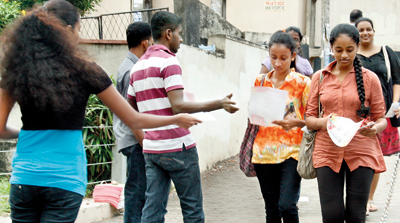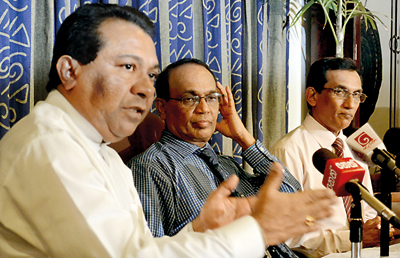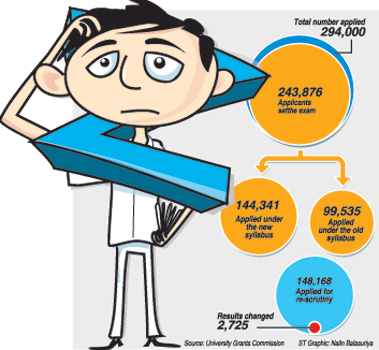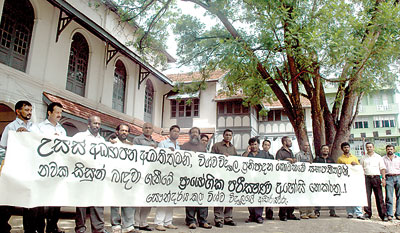News
Zeroing on Z- score fiasco
View(s):The Z-score calculation for university admission is once again in the spotlight following last week’s Supreme Court decision, with the new development bringing fresh hope to some students and confusion to others while education authorities are embroiled in a blame game.

Uncertain future: Students who fear that the revision of the Z- score will hinder their admission to University read leaflets pertaining to A Level revision classes last morning. Pic by Indika Handuwala
- Uncertain future: Students who fear that the revision of the Z- score will hinder their admission to University read leaflets pertaining to A Level revision classes last morning. Pic by Indika Handuwala
The Supreme Court ordered the University Grants Commission (UGC) to annul the 2011 G.C.E. Advanced Level examination Z-score calculation and recalculate for the old and new syllabus separately.
The 2011 calculation was done according to a pooling formula for the first time since the Z score was introduced, with results of the both syllabuses being merged and calculated.
In 2001 Peradeniya University senior Professor of Statistics R.O. Thattil and a panel of experts introduced the Z-score formula for university admission.
“When the new calculation was introduced, I pointed out that there will be issues in merging results of two syllabuses and the Z-score marks will be erroneous.
It is incorrect to put two populations together; it’s like adding biology and history. Every single paper had two syllabuses, both had a different number of questions and the marks allocated have a difference too,” Prof. Thattil told the Sunday Times.
He said despite concerns, the UGC went ahead with the new formula and even after a number of complaints, education authorities did not consider going for a re-calculation. “The SC order comes as a relief especially to students. This issue could have been solved earlier if the experts panel had convinced the authorities that there was a need to re-calculate,” he said.
In 2011, 243,876 students sat the Advanced Level examination with 144,341 from the new syllabus and 99,535 from the old.
The Examinations Department received the highest number of re-scrutiny applications, 148,168 (57 percent) for A/Level this year. Following the SC order that called for separate re-calculation, the re-scrutinised A/Level results of 2725 students changed. Claiming that the UGC has to accept responsibility for causing this blunder and inconveniencing the students, Prof.Thattil said he had received a request last week from the Higher Education Ministry Secretary seeking his assistance regarding the formula.
Meanwhile, educationist and former Dean of Colombo University’s Faculty of Education, Prof. S.Chandrasekaran said it was unfortunate that there were so many cases of fundamental rights violations in the field of education. “From school admissions, to the Ordinary Level and Advanced Level exams there have been many instances where the Supreme Court had to get involved.
Education authorities should be more responsible in their decisions,” he said.On Tuesday (26), a news conference was held at the Higher Education Ministry by a panel comprising Higher Education Minister S.B.Dissanayake, UGC Chairman Professor Gamini Samaranayake and Prof.Sarath Kulatunge, representing the experts who came up with the 2011 formula for the A Level results.
Minister Dissanayake said the re-calculation will take place according to the court order but refused to comment whether the formula used for the 2011 A Level examination was a failure.Prof. Samaranayake said legal assistance will be sought to clarify certain areas of the judgment, especially with regard to which authority was responsible.

S. B. Dissanayake and Prof. Samaranayake at the news conference
Prof. Kulatunge said the panel would stand by its formula and that both, pooling of the two syllabuses and separate methods were tried out.When contacted by the Sunday Times to explain the 2011 Z-score formula combining both A Level syllabuses he refused to comment stating that it was based on scientific evidence and to minimise injustices to students.
“We respect the SC decision and now that the panel has been dissolved there is no need to explain more on it. But it has been a proven method,” Prof. Kulatunge said.The five member panel of the 2011 Z-score formula included senior professors and heads of departments of statistics from the universities of Colombo, Kelaniya, Moratuwa and Sri Jayawardhanapura.
Despite opposition parties calling for the resignation of Higher Education Minister S. B. Dissanayake and Education Minister Bandula Gunawardena their portfolios over the 2011 Z-score fiasco, both ministers have not taken the responsibility over the issue.Minister Gunawardena said that neither he nor the Examinations Commissioner was responsible as the Exams Department issued the results based on the formula prepared by the UGC, coming under the Higher Education Ministry. Minister Dissanayake also said he need not resign, as Z-scores will be released within a month’s time and students will enter university in October as in previous years.
Meanwhile, students who have been waiting for almost a year to gain admission to universities accuse the education and higher education ministries for being inconsiderate of their future.Ranjula Herath (19) who sat for the A/L’s last year in the commerce stream charged that it was a waste of time.
Those who had good ranks are sure of entering university. But those who are on the border are uncertain of their future she said, adding students who obtained medium-level scores did not apply to university but now with the re-calculation they are not sure whether they will be eligible for university admission.

“I started CIMA and also a part time job while awaiting university admission. But we were not called for the leadership training that was scheduled to begin in May,”she said.
Christjit Xavier (19) sat for the A/L’s in the Bio stream offering Biology, Physics and Chemistry as subjects.
“I obtained 2 A’s and a B and was expecting to enter the Medical Faculty. Now I’m worried about the Z-score and district rank,” he said adding that many of his colleagues have applied for scholarships offered by India and Bangladesh.
“Even to apply for scholarships we need the ranks and this mess created by education authorities has caused a lot of difficulty to students,” he said.
Zahrah Rizwan(19) sat for the A/L’s in the Arts stream. “At the beginning I was really enthusiastic about getting into university. I applied to Colombo, Kelaniya and J’pura universities. But now I don’t know whether the ranks will change,”she said.
National Institute of Mental Health Consultant Psychiatrist Dr. Harischandra Gambheera said these situations can cause a high level of stress among students, especially in a competitive university entrance system.
How the Z-score is calculated
- The average marks (mean) of each subject is obtained by dividing the total number of marks by the number of candidates.
- Then the average marks (mean) is subtracted from each student’s marks on each subject.
- This is divided by the ‘standard deviation,’ a widely used measure of variability.
- Then the Z-score for each subject by a student is obtained.
- This figure is totalled and divided by the number of subjects (three) to arrive at the Z-score.
- The results obtained by each candidate are then placed on a district and island-wide ranking.




















